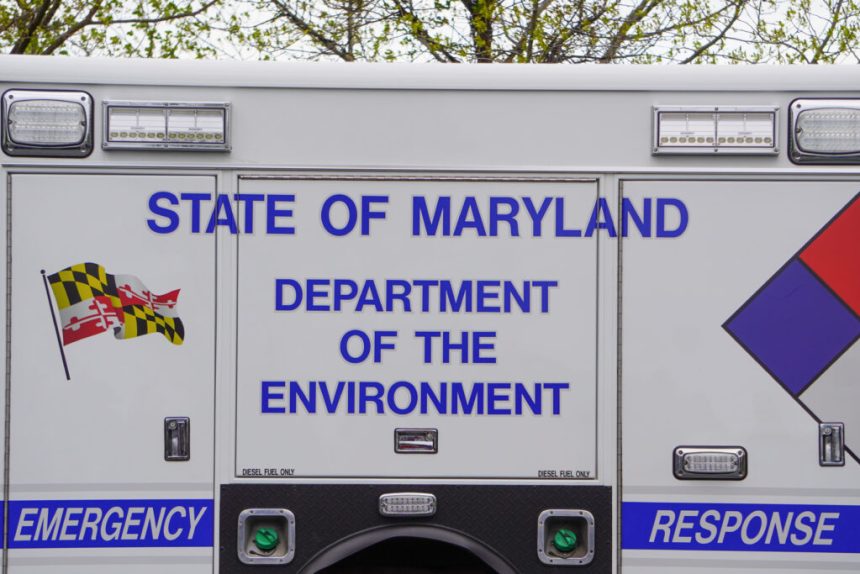A Maryland Department of the Environment emergency response vehicle is on display at a press conference in Essex on April 15. (Photo by Christine Condon/Maryland Matters)
A new stormwater permit meant to control runoff of polluted rainwater from state roads into state waterways is a “critical missed opportunity,” according to environmental groups, who say the new guidelines backtrack from previous requirements.
The five-year permit, issued Friday to the State Highway Administration by the Maryland Department of the Environment, sets a requirement of controlling runoff on more than 4,000 acres owned by SHA, which is backed up by $216 million in combined state and federal funding, officials said.
“This permit strengthens our ability to protect the Chesapeake Bay and the businesses and communities that rely on it, manage stormwater in overburdened areas, and make our state an even more desirable place to live,” Maryland Environment Secretary Serena McIlwain said in a statement Friday.
But advocates, from groups like the Chesapeake Bay Foundation and Maryland League of Conservation Voters, said the new permit actually targets less acreage than the last five-year permit did, and it largely leaves it to the SHA to decide what methods it will use to achieve runoff control.
Instead of flexibility, the advocates were hoping the new permit would require more effective runoff control measures, like tree plantings and stormwater ponds that trap water before it reaches natural waterways. But the state highway system can utilize other methods to comply too, including street sweeping, stream restoration and pollution credits.
The advocates say those methods aren’t as helpful, in part because they don’t do as much to stop harmful nutrients from running off the streets. Environmental groups and scientists have also cast doubt on the efficacy of some stream restoration projects, which modify stream banks in an effort to curtail erosion.
“We wanted [MDE] to put a cap on … the things that are of lesser value, and a bare minimum on the important things — and they just didn’t do that,” said Evan Isaacson, a senior attorney with the nonprofit Chesapeake Legal Alliance, which represents clients in environmental litigation.
Isaacson added that he remains hopeful that state officials will take the feedback into account, and select the most efficient methods to meet the permit requirements.
SHA spokesperson Shanteé Felix said in a statement that the agency will “utilize a balanced approach of MDE approved strategies that are feasible within the current budget to meet the requirements of the permit.”
Matt Stegman, a staff attorney for the Bay Foundation who focuses on Maryland, said the advocates’ preferred methods also provide more lasting change.
“If you plant a tree, eventually it’s going to be there for decades, as opposed to if you sweep the street, you’ve got to come do it again next week,” Stegman said.
Kim Coble, executive director of the Maryland League of Conservation Voters, said in a statement Friday that she doesn’t feel as though the permit takes a strong enough stance to ensure that projects happen in communities near state highways dealing with pollution and flooding concerns.
“Unfortunately, this permit takes a minimalistic approach that fails to prioritize projects addressing climate resilience and water quality in communities most burdened by pollution,” Coble wrote.
But an MDE news release noted the new permit requires SHA to report back about environmental restoration efforts in communities “with environmental justice concerns,” meaning they’re considered historically underserved and overburdened by pollution. The permit also allows for “expanded collaboration” with scientists and other experts to improve data collection, and includes $2.5 million in new funding to perform flood risk studies.
As much as they find shortcomings in the new permit, environmentalists acknowledge it could have been worse: A draft version of the permit released last year was severely criticized.
The previous permit required that SHA take runoff control measures on 20% of its total acreage. The 4,000 acres in the new plan represent 15% of SHA land — but that’s better than the 11% goal in last year’s draft version.
MDE officials had called the proposed restoration of 11% of impervious acreage “consistent with” Chesapeake Bay restoration goals, but said they heard the feedback and agreed to raise the target to 15%.
“As part of these discussions, … SHA indicated a desire to lead by example based on the most recent State budgetary projections: increasing the … commitment to 15% during the next permit term. Thereby, reducing more pollutants from the stormwater sector toward the restoration of the Chesapeake Bay,” reads the permit document.
SUPPORT: YOU MAKE OUR WORK POSSIBLE
Isaacson said he’s frustrated that SHA is being asked to restore less acreage than in the prior iteration of its permit. Advocates say that stormwater runoff is one of the more vexing categories of pollution endangering the effort to reduce pollution in the Chesapeake, making improvements all the more important.
Computer modeling data from the Chesapeake Bay Program shows that pollution from “developed” lands, largely stormwater, has increased since bay restoration efforts started in 1985, while other sources, including agriculture and wastewater treatment, have improved their numbers.
These stormwater permits, which are also issued for other sectors and for counties in Maryland, have been the subject of legal challenges in the past. A 2022 suit by a number of environmental nonprofits challenging Maryland’s stormwater permit for industrial facilities is still underway.
It unclear if a legal challenge is in the future for Friday’s permit.
The new permit comes at a challenging time for the multistate effort to improve the bay. After falling short of goals for 2025, the bay states have released a revised agreement, with a range of deadlines five, 10 and 15 years in the future. The Bay Program is accepting comments from the public on that plan through Sept. 1.
Isaacson said Friday’s permit is an example of how lackluster decisions by the participating states can sour the overall effort to meet the cleanup goals.
“They can say all these great things about what they’re committing to in the new bay agreement,” Isaacson said. “When they actually have to do something, they don’t make great decisions.”
A 2023 report from the Bay Program’s Scientific and Technical Advisory Committee, indicated the need for a more targeted approach to so-called “non-point” pollution — pollution, like stormwater, that doesn’t come directly from a facility’s discharge pipe. The report argued that states should cluster pollution reduction practices in areas with the greatest potential to reduce runoff into the bay.
“That status quo has been random acts of restoration,” Isaacson said. “That’s the status quo that we seek to change.”









